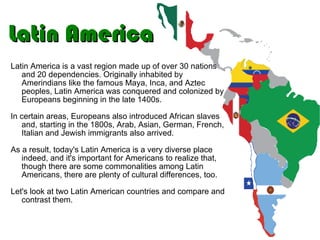
Latin america
- 1. Latin America Latin America is a vast region made up of over 30 nations and 20 dependencies. Originally inhabited by Amerindians like the famous Maya, Inca, and Aztec peoples, Latin America was conquered and colonized by Europeans beginning in the late 1400s. In certain areas, Europeans also introduced African slaves and, starting in the 1800s, Arab, Asian, German, French, Italian and Jewish immigrants also arrived. As a result, today's Latin America is a very diverse place indeed, and it's important for Americans to realize that, though there are some commonalities among Latin Americans, there are plenty of cultural differences, too. Let's look at two Latin American countries and compare and contrast them.
- 2. Let's look at the cultures of Chile and Mexico. Chile Population: 16,746,491 Area: 756,102 sq. km. Per Capita GDP: $13,880* Mexico Population: 112,468,855 Area: 1.964,375 sq. km. Per Capita GDP: $14,104* *U.S. Dollars
- 3. Sports and Recreation Let's start with the fun stuff: Here in the U.S., we love football, baseball, basketball and a variety of other sports, but in Chile and Mexico—as in much of the rest of the world-- soccer (Futbol) is king. In Mexico, bullfighting draws the second largest crowd, and a unique variety of professional wrestling called la lucha is also very popular. Mexicans enjoy their own form of rodeo called charreada. Chileans are rapidly becoming basketball fans. They also enjoy theater, music and anything that can be done outdoors—especially activities like swimming, fishing and surfing that take advantage of their giant coastline. Chileans, like Mexicans, have their own unique form of rodeo. The main event in theirs features a pair of cowboys (huasos) on horseback who attempt to pin a steer against a wall.
- 4. Food and Dining In the U.S.A, most people eat three meals a day, with the largest meal being the last. That's generally not true in Mexico or Chile. Many Mexicans eat four meals a day, with the largest meal in the late afternoon. In Chile, the main meal is enjoyed mid day followed by and afternoon tea and a light meal in the late evening. Whereas dining in the United States is often an informal, hurried and mobile affair, meals are important in both Mexican and Chilean cultures and never rushed. Dining doubles as a forum for relaxed conversation and, though both Mexicans and Chileans—especially urban dwellers—often eat in restaurants, both cultures consider it impolite to eat while walking...with the possible exception of enjoying an ice cream cone.
- 5. Holidays Just as in the United States, Chile and Mexico celebrate holidays based mainly on religious traditions and important political and social events in history. Aside from these, Mexico is sole home to an iconic holiday on November 1-2, The Day of the Dead, in which Mexicans honor their departed loved ones. Contrary to popular belief here in the states, Cinco de Mayo celebrates an 1862 victory over the french and is not Mexico's independence day, which is actually September 16. Chileans celebrate Christmas much like Americans do, but value New Years Day even more as a day to gather with family. Known for their patriotism, Chileans naturally make a outdoor party of their Independence day on September 18.
- 6. Gestures & Attitudes While,In the United States, people tend to describe themselves as “over-scheduled,” but in both Mexico and Chile, there is a general relaxed attitude towards time. While this is a disappearing trend in the urban workplace, it's still true in social life. A common greeting in Chili is called the Abrazo. It's a handshake and hug, plus a kiss on the right cheek for females and family members. Mexicans often greet with a handshake or nod, with hugs reserved for close friends. Women often greet with a kiss on the cheek and men sometimes greet women the same way. Mexicans speak to one another standing closely, with frequent gesticulation, while Chileans value eye contact and correct posture during conversation.
- 7. Conclusion U.S. citizens value individualism and, likewise, shouldn't expect all Latin Americans to communicate, speak, or otherwise behave identically. It's important not to generalize about Latin Americans and, instead, to make an effort to understand the many nuances the sprawling term Latin American attempts to contain. Doing a little research is a great start toward that cultural understanding, but nothing beats having an open mind and personally getting to know people from all across the Latin American Spectrum.
- 8. The cultural information and images for this presentation were found in: Culturegrams Online Edition. ProQuest (2010) Presentation created by: Jeffrey Hastings For SPAN/502
